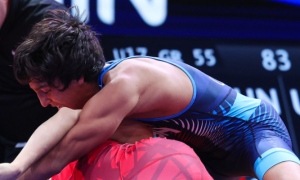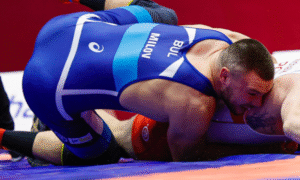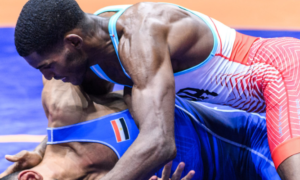We continue our exploration into proposed, useful Greco-Roman wrestling statistics with perhaps the most important area of study: par terre.
Par terre was represented with its own statistical measurement in the introductory piece published earlier this month. Dubbed PTSM (Par Terre Scoring Per Match), this is a metric which averages overall points scored from par terre in relation to a workable sample size. Though valuable, in and of itself PTSM is rather limiting.
Does PTSM shed a light on competence? Sure. Does it provide a snapshot one could use in an effort to better understand a wrestler’s prowess from par terre top contrasted with other positional dynamics pertaining to one match or a slew of matches from a tournament? You bet.
But what PTSM fails to demonstrate is efficiency, which is to say how often a wrestler from top/offensive par terre turns or lifts their opponent compared to the number of chances they receive to do so.
Remember: we are* observing par terre as a “static” position, and dismissing actions on the mat which began on the feet. Forced or “ordered” par terre is not mandatory, there simply has to be a pause where the bottom wrestler demonstrates the ability defend. Dennis Hall puts it better. “The bottom guy has to at least have the chance to defend and not already be screwed,” he said, and that sums it up adequately.
The good news is that once the starting point for par terre is understood, describing how to observe and calculate influential actions does not necessitate a grand literary odyssey.
The highlighted athlete this time around is Max Nowry (60 kg, Army/WCAP, world #3 at 55 kg). At the 2019 World Championships, Nowry came up one win shy of a bronze medal in what was a very impressive effort. That is not why he is the case study. It has much more to do with the fact that all four of his matches included relevant par terre examples. Nowry’s appearance in the tournament saw reasonably balanced opportunities for him to attack from par terre as well as defend.
Par Terre Offense
We are already equipped with PTSM, which is a blanket statistical category responsible for adding up offensive par terre points from a series of bouts and determining the average. On an island, PTSM is a worthy baseline stat and good for a quick glance following a wrestler’s performance at a tournament or event.
Example: Joe Rau (87 kg, TMWC/IRTC, world #7) competed in three matches at the Pan-American Championships in March and strung together a total of eight points from par terre top.
8 par terre points divided by 3 matches = 2.6 PTSM
What we want to do now is investigate how efficiency ties into points yields — just like with ACR (Attempt Conversion Rate). Attempts, specifically on the feet, certainly matter; what matters more or just as much is the frequency in which an athlete is able to convert. How critical is this concept? Extremely. The majority of victories earned via technical superiority are the result of par terre, and par terre via passivity is likewise the catalyst for more than its fair share of game-changing scores.
Back to Nowry, who presents a slight problem in his very first match at the ’19 Worlds.
His first opponent was Fabian Schmitt (GER). Not to delve too far into a backstory, but Schmitt and Nowry went 1-1 against each other in the ’18 German Grand Prix. Nowry won the first match, Schmitt won the second (and the following year earned bronze at the European Championships).
But in Kazakhstan last September, Nowry turned a 1-0 second-period deficit into a runaway 10-1 tech. He scored four from an arm throw, was stood up, and then piled on soon after with a takedown and two turns.
The closing sequence is available in the video clip below (press play).
The one thing to be avoided at all costs is subjectivity. Origin of score is the preeminent factor to consider when organizing and calculating statistics. Are the two trap-arm turns from Nowry par terre scores? Yes, and here is the reason why: Nowry did not have Schmitt’s arm until after securing the takedown. Schmitt also had a fine opportunity to flatten out or engage in a more effective defensive position. Instead, he chose to stay on his base. What’s more, Schmitt even tried using his right leg to interfere with Nowry’s, though that wound up completely inconsequential.
Below offers the two trap-arm turns by Nowry without the takedown with the tally coming in at four points. In the match, Nowry had two legitimate opportunities from par terre top and scored on one of them. Keep that in mind for later.

After dragging Schmitt to the mat, Nowry caught a trap-arm gut and rotated the German once before settling for a tilt to close out the match. (Image: UWW)
In the quarterfinal, Nowry lost a thrilling 3-2 decision to eventual runner-up Khorlan Zhakansha (KAZ, world #2). The American was able to net a takedown in the first period — but it led to an immediate scramble and thus does not qualify as a par terre chance.
With Zhakansha having earned a huge win in the semifinal over ’18 World Champion Eldaniz Azizli (AZE), Nowry was given new life in the repechage where he faced off with Abdelkerim Fergat of Algeria. Here, he did some work. Nowry took the first-period passivity point and proceeded to rake Fergat for six points.
Fergat got his own passive try in the next period and did manage to grab a gutwrench for two; however, Nowry picked up four more points on the strength of a pair of takedowns to notch his second tech fall of the tournament (in two victories = 100% VFR) as well as sail into the bronze match against Azizli.
Unfortunately for Nowry, that contest did not present a top par terre opportunity. Azizli scored a quick takedown and rolled three guts to end it in the first period.
PTEP
So now it comes down to isolating Nowry’s par terre chances and finding how many times he was able to net an offensive score. This requires two steps. The first is applying the qualifying mechanism “Par Terre Opportunities” (PTO). PTO’s are (in the current rule-set) confined to the first passivities in each period and can become available following takedowns or other offensive scoring actions.
The second step illustrates “Par Terre Execution Percentage” (PTEP), which will eventually take its rightful place as one of our most widely-used statistical categories. Deciphering the PTEP is a breeze and it also answers an important question: How many times did an athlete successfully score from top par terre compared to the number of opportunities he was given?
Bear in mind we are not counting number of techniques, nor are we worried about points yield. PTEP is situational. All we are doing is looking at the number of chances Nowry had from par terre top and noting when he scored — not how many guts he executed, or how many points were accumulated. Points from par terre are not a component of PTEP but are obviously the inspiration for PTSM.
Even still, for this maiden voyage points and methodologies are displayed in the summary below as a way to emphasize how PTEP is observed.
vs. Schmitt
Period 1: Nowry — 0 PTO; Schmitt — 1 PTO, 0 success
Period 2: Nowry — 2 PTO, 1 successful (two gutwrenches for for four points)
vs. Zhakansha
Period 1: Nowry — 0 PTO; Zhakansha — 0 PTO
Period 2: Nowry — 0 PTO; Zhakansha — 1 PTO, 1 successful (one gutwrench for two points)
vs. Fergat
Period 1: Nowry — 1 PTO, 1 successful (three gutwrenches for six points)
Period 2: Nowry — 0 PTO; Fergat 1 PTO, 1 successful (one gutwrench for two points)
vs. Azizli
Period 1: Nowry — 0 PTO; Azizli — 1 PTO, 1 successful (three gutwrenches for six points)
PTEP — 66%
2 successful scoring sequences divided by 3 PTO = .66
Par Terre Defense
In the tone-setting intro article, it was said that offense “should be what people think of first pertaining to Greco competition.” Make no mistake, that is absolutely 100% true. Nothing is more vital to the health and perception of Greco-Roman wrestling — especially at the Senior level internationally and for sure in these United States — than offense.
People want action. Fans like to watch big throws, and athletes like to hit ’em. Slick arm drags to go-behinds, booming side lifts, waterfall bodylocks, out-of-nowhere saltos, vicious front headlocks… Wonderfully adrenalizing techniques are what largely drive Greco’s marketability.
But much like other sports, defense is paramount. And in Senior Greco, solid par terre defense is virtually mandatory.
At the highest reaches of Greco-Roman, we are dealing with a “turn and not-get-turned” game. Careers, let alone results from matches or tournaments, can very often be traced back to how stout an athlete was when it came to par terre defense. It is the ultimate line of demarcation separating legitimate contenders from everyone else, and it is also an area of concentration for every full-time athlete on the planet.
Which is why we need to attach a statistical significance to it.
PTDR
Thankfully, the inverse to PTEP is just as easy to measure.
How many times an athlete stopped their opponents’ PT attacks divided by the number of times the athlete was on par terre bottom gives us “Par Terre Defend Rate” (PTDR). We will use the prepositional phrase acronym “Par Terre Bottom” (PTB) as the qualifier. For the sake of this stat, the word “defend” is a noun that indicates that the athlete on PTB did not surrender any offensive points.
Once again, we are not interested in techniques or scoring totals. We just want to know how many times Nowry was able to stop his opponent from scoring compared to how many times he was on PTB.
vs. Schmitt
Period 1: Nowry — 1 PTB, 1 defend; Schmitt — 0 PTB
Period 2: Nowry — 0 PTB; Schmitt — 2 PTB, 1 defend
vs. Zhakhansha
Period 1: Nowry — 0 PTB; Zhakansha — 0 PTB
Period 2: Nowry — 1 PTB, 0 defends; Zhakansha — 0 PTB
vs. Fergat
Period 1: Nowry — 0 PTB; Fergat — 1 PTB, 0 defends
Period 2: Nowry — 1 PTB, 0 defends; Fergat — 0 PTB
vs. Azizli
Period 1: Nowry — 1 PTB, 0 defends; Azizli — 0 PTB
PTDR — 25%
4 PTB divided by 1 defend = .25
PTPS
PTSM recognizes the average number of points an athlete scored from top par terre. That means there needs to be an opposite. This is where PTPS, or “Average Par Terre Points Surrendered” makes its entrance.
Simple: just add up all of the points an athlete gave up from PTB and extract the average.
vs. Schmitt
Nowry — 0 par terre points surrendered
vs. Zhakhansha
Nowry — 2 par terre points surrendered
vs. Fergat
Nowry — 2 par terre points surrendered
vs. Azizli
Nowry — 6 par terre points surrendered
PTPS — 2.5
10 par terre points surrendered divided by four matches = 2.5
Nowry’s final par terre stat line from the 2019 World Championships (5th place at 55 kilograms):
PTSM — 2.5
PTEP — 66%
PTDR — 25%
PTPS — 2.5
A potentially fun exercise for fans (and productive one for coaches) would be to compare PTSM and PTPS. Side-by-side, these two categories can tell a lot about how an athlete is performing.
If, for example, a wrestler’s PTSM is higher than their PTPS — drawing from either a single tournament or collection of tournament results — right away it is clear that they are at a positive point differential in par terre. If a wrestler is scoring more points than they are surrendering from the position, it might not be a stretch to assume that their records/results would reflect that fact. And, of course, vice-versa.
Nowry finished the ’19 World Championships with a PTSM of 2.5 and a PTPS of 2.5. His output and defense from par terre were essentially negligible numbers-wise. What a zero-point differential between par terre offense and defense represents is likely in the eye of the beholder, thus elevating the imperative nature of context. All four of Nowry’s opponents were excellent, and at the time of the Worlds, ranked by UWW. One (Azizli) had already been a World champ.

Nowry (right) listens to Army coaches Spenser Mango (center) and Bruce Robinson (left) in between periods against Abdelkerim Fergat (ALG) in the 55-kg repechage at the 2019 World Championships in Nur-Sultan, Kazakhstan. (Photo: UWW)
But the context is not just how high of a caliber the opposition was. It is also available when referencing other stats along with the par terre metrics. If you truly want a complete picture of how an athlete performed, a full comparison is how to render it.
Nowry — 2019 Worlds
For a full explanation of each statistical category, please reference this article for general stats, and this one for Counter Scores.
OPA: 5.75
OPP: 3.28
PPM: 5.5
PPP: 3.14
VFR: 100%
CSPM: 9.5
AMV: 8.0
APM: 2.5
APP: 1.4
ACR: 3.3
MPSM: 2.5
TCSP: 4.0
CSA: 1.0
PTSM — 2.5
PTEP — 66%
PTDR — 25%
PTPS — 2.5
A VFR of 100% at the World Championships? Nice. An AMV of 8.0 similarly indicates you’re getting guys out of there early. Nowry even picked up a couple of counter scores along the way. Considering those baseline stats — plus a lofty 66% PTEP and MPSM of 2.5 — it is easy to see why Nowry found himself in the medal hunt.
PT Stat Summary
Other than a brief absence three seasons ago, par terre has continued to play a major role in Greco-Roman wrestling. As long as it remains in the rule-set, a valid viewpoint might be that no other position is as influential with regards to outcomes at the Senior World/Olympic level. Par terre, for better or worse, decides more matches currently than anything that happens on the feet. That’s why, at least on this platform, it is consistently referred to as “the great equalizer”. Par terre is where strengths are revealed, and weaknesses, exploited. It is where momentum can change in an instant, and where the exhibition of clutch defense is most readily apparent.
One PT stat was in the books prior to this latest (and conclusive) deep dive into Greco metrics. Three more being added (PTEP, PTDR, and PTPS) will hopefully satisfy those who are eager to track and measure progress, or simply catch a glimpse of how affecting the classical style’s version of mat wrestling really is at the top level of the sport. Certainly, these stats can be applied among all age divisions; but it is at Senior where the consequences of par terre are weighed the heaviest.
Several have had a hand in contributing to this material. Hall, for one. His guidance, technically and otherwise, is not exactly a secret. But also, insights from Patrick Smith (77 kg, Minnesota Storm, world #18), Kamal Bey (77 kg, Sunkist), Joe Rau (87 kg, TMWC/IRTC, world #7), and Gardner Wheeler of 3D Wrestler Stats helped shape the finished product. Although, there may be adjustments in the future, depending on what is discovered through more investigation, additional feedback, and trial-and-error.
For now, we all seem to feel this direction is the right one. The objective of our statistical categories for Greco-Roman is to offer a different perspective of what constitutes athlete competence while providing the community with fun, easy-to-follow metrics they can recognize and reference when appropriate. In the meantime, our entire Greco-Roman stat glossary will be moved into a centralized content format on 5PM coming up very soon. Hope to see you there!
Listen to “5PM37: The wildman Sammy Jones” on Spreaker.
SUBSCRIBE TO THE FIVE POINT MOVE PODCAST
iTunes | Stitcher | Spreaker | Google Play Music





















